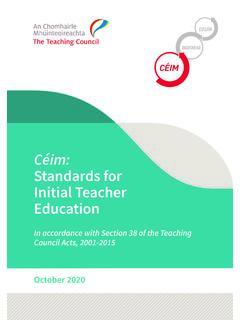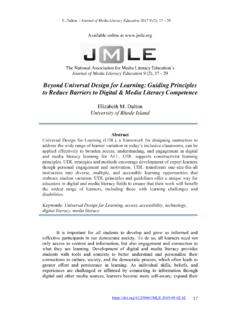Transcription of Reflection and Planning Guide - Flight
1 Play participation possibilitiesReflection and Planning Guide2 ight | Alberta s Early Learning and Care Framework | and Planning Guide OverviewThis section supports early learning and child care educators in their Reflection and Planning processes. The Reflection and Planning Guide assumes a strong, capable image of the child and family, described in the previous documents, The Image of the Child: A Mighty Learner and Citizen and A Practice of Relationships: Your Role as an Early Learning and Child Care Educator. Within the Alberta curriculum framework, content begins with the experiences of children and engages educators as co-learners, co-researchers and co-imaginers of possibilities.
2 In these roles, educators are encouraged to make use of a co-inquiry process1 and emergent curriculum2 Planning in ways that notice and name what children are doing in their play, learning and development; reflect and interpret using the curriculum goals and children s dispositions to learn; and then, co-imagine possibilities with children, families and colleagues for further exploration and play. The physical and responsive environment including time, space, materials, and participation changes to reflect how educators make meaning of the curriculum that children are already engaged in through this emergent and reflective process.
3 As co-learners, co-researchers, and co-imaginers of possibilities, you are: Observing and documenting what children are doing in the environment with others, with materials, and within the organization of time. Being curious about what children are doing and wanting to accomplish in their play, learning and development situates you as a co-learner alongside them. Your recorded observations might be an assortment of many different forms of documentation, such as photos, video, audio recording, anecdotal notes, and collected artifacts made by children and/or scribed words expressed by children. As you revisit and reflect on your documentation you might begin to see patterns in children s play, such as continued interests, repeated use of objects, common play groups.
4 3 Reflection and Planning Guide Reflecting and interpreting your observations and also reflecting on your observations and documentation may cause you to have further questions. You may begin to wonder: How are other children using this play space? In what other situations does this child explore her persistence? What other natural materials will encourage seeking for these children? What other materials would nurture his participation in play? In what other ways does this child demonstrate caring for others? Think about what you saw children doing and trying to accomplish. What surprised you?
5 You may have questions for the child s family or your colleagues in regards to how a child is approaching particular ideas, materials and social play experiences. The curriculum framework goals can be used to interpret your observations of the children s play, learning, and development. As a co-researcher you may also gather insights from families and colleagues to help you understand more deeply what children are doing or trying to accomplish in their play, learning, and development. Seeking additional information and insights from children, families, and colleagues, as well as, workshops, professional journals and books, and conferences can help you to further understand your observations and reflections of children s experiences and your curriculum decisions.
6 Planning and taking action to provide further experiences that invite children to pursue their ideas and theories, challenge ideas, explore, invent, create, and play in active ways that engage children s senses and whole body movement. Your observation and documentation, and Reflection and interpretation of what children already know and can do and/or are trying to do in their play, learning, and development helps you to make further curriculum decisions that can nurture and support their efforts. Co-imagining possibilities is made more dynamic as you invite the children, families, and colleagues to invent and create further opportunities to expand on children s experiences.
7 Your curriculum decisions are made visible in the design of a responsive play and learning environment and the design of care routines, as well as your interactions with children and ight | Alberta s Early Learning and Care Framework | co-inquiry process and emergent curriculum Planning is cyclical. When you observe and document, reflect on and interpret, and plan and take action in ways that expand and extend children s play, learning, and development, and nurture their dispositions to learn, you create a responsive care, play and learning environment. A responsive environment reflects each child as a strong, resourceful, and capable mighty learner and citizen.
8 Inspired by Abramson, S. (2012). Co-Inquiry: Documentation, research, action. Co-imagining Possibilities Planning and Taking Action Reflection & Planning Guide Wondering Playing with ideas What can we do next? Engaging playfully Observing againCo-researchingReflecting and Interpreting The narrative of a learning story Curriculum Cross-checking What does the curriculum framework tell us? Connecting to Concepts, Goals and Dispositions to Learn What can we learn from theory? What is my/our image of this child/children?Co-learningObserving and Documenting Listening to children Documenting play and ordinary momentsTalking the Documentation Asking questions Drawing on multiple perspectives What are the possible meanings of this play?
9 A Model of Co-Inquiry for Co-Constructing Curriculum5 Reflection and Planning GuideHow to read and use the Reflection and Planning GuideAt first glance, you might read the Reflection and Planning Guide (sample on page 8) from top to bottom and left to right. This is not the only way to read the chart. As you become more familiar with a co-inquiry process and emergent curriculum Planning that originates with children, you may start to explore the ideas in the Guide from multiple points of begin, however, reading from left to right across the top of the Guide , the title Environments for Learning and Care: Time, Space, Materials, Participation is followed by seven dimensions of the environment.
10 These statements are intended to provoke you to think about and look at the playroom environment that you share with children and families. Words and statements such as offer; provide and model; talk and reflect on; model, facilitate, and scaffold; welcome and invite; plan and participate; and be intentional in what you model, are intended to inspire you to take action in collaboration with children, families, and from top to bottom along the left side of the chart, five dispositions to learn are listed: I/we are playing, I/we are seeking, I/we are participating, I/we are persisting, and I/we are caring.



